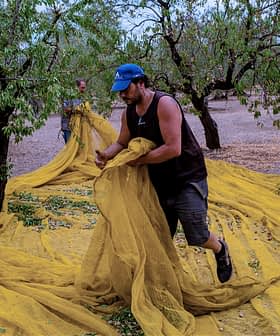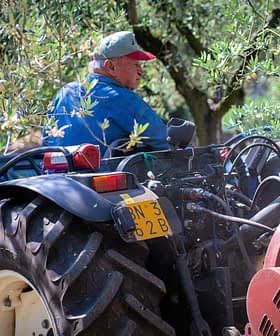Gennaro Pieralisi is concerned about the low prices for olive oil. There’s too much extra-virgin olive oil and too little demand. The financial crisis has consumers all over the world cutting back on their expenses. He is in command of the break-even prices on olives, reeling off the numbers: for Spain it’s 2.70 – 2.80€ per kilo; for the other EU countries it’s 3.60 – 3.70€ per kilo; and 2.50 € per kilo for countries like Tunisia, Algeria, Morocco, Syria, Jordan, Turkey and for the South American countries. The variance is due to labor costs. Pieralisi doesn’t say this, but I infer that the depressed price for olive oil must impact the ability of growers’ to buy or upgrade machinery.
I ask him about the recent drop in the value of the euro and he says this will help him, and adds that it will benefit all European manufacturers. Pieralisi does provide some financing to enable purchase of his equipment. He’ll allow Italian buyers to stretch payments over five years. He won’t do that outside of Italy because it would be too difficult to sue buyers who default on their payments. He says he wants to be paid upfront for the machines. The company refurbishes used machines and, typically, these cost a third less than new ones.
See Also:A Conversation with Gennaro Pieralisi
The season for olive oil is relatively short and this is one of the reasons the company has diversified. These subsidiary ventures involve centrifuge technology, but for other applications. Pieralisi makes centrifuges for the cheese industry. They sell centrifuges to makers of Parmigiano Reggiano, for example, who use them to spin the cream away from the milk. For mozzarella, the Group produces an entire system. Centrifuges are sold to fruit juice makers, vintners, and tomato processors in the food space. Then there’s the industrial division, separating sludge, fuel oil purification, wastewaters etc. I ask him if it’s difficult to market machines for things that taste so good alongside these other areas and he acknowledges that it is a challenge. The diversification, however, keeps everyone working steadily – the Ingegnere seems particularly concerned that the service groups have enough to do.
Pitted olive oil has recently been in the news and asked about it he says, “It’s dead on arrival. Dead on arrival because it’s invented and motivated by marketing. For every 100 kilos of olives, there’s 750 grams of oil from the almond in the pit, it’s a very characteristic and rich oil, rich in polyphenols and topophenols. Without the oil of the pit, the olive oil lasts only six months. And beyond this, the pitted oil is very insipid. It was simply a way of launching a marketing message.” I ask him if he has any new breakthroughs he wants to share, and he says he’ll have something in a couple of years. Pieralisi explains that the olive oil season is so short, a maximum of 100 days, and so the experimentation period is limited. He also says that November 2nd, the day the extraction season starts and the ten days that follow is an inferno – with every customer starting the extraction of oil. It can’t be that bad since he says the word inferno with a smile.
On questions of taste in olive oil he says that it is a matter of one’s own personal taste and tradition. He says that to someone from Bari, the perfect oil might be from the Coratina olive tree, but to someone from Lake Garda that oil is “bitter like poison.” And the Milanese and other North Italians, who are used to the taste of butter, “prefer an insipid oil.” He personally favors Greek olive oil. (The Gruppo Pieralisi make extra-virgin olive oil, and more about this later, but at this moment he’s too proud a character to say it’s his favorite.) He talks a bit about large companies like Unilever, who sell to supermarkets worldwide, and says that they buy mixes of olive oils in order to keep the taste consistent, they’re looking for a uniform taste. With those oils there isn’t a good year and then a bad year.
Because he’s talking about mixtures, I inquire about adulterated olive oil. “The classic mixture is olive oil and high oleic safflower oil. Up to 7% safflower oil is undetectable in olive oil and that’s one way people lower their costs.” We talk about the olive oil exported to America, he says it’s always been the lowest quality, often mixed with pomace oil, and he says it’s the fault of the American legislature, since they don’t recognize extra-virgin olive oil. He thinks that this will change because of California’s increasing olive oil production [ Editor’s Note: The USDA recently recently revised standards to be consistent with those of the International Olive Council ]. The “Made in Italy” and an Italian flag on a bottle of oil carries a premium, and much of the oil that is sold as Italian, is not made in Italy. Pieralisi says that before it was only Italians who would import the oil, bottle it and sell it as Italian. Now, the Spanish have gotten wise to this, have bought Italian companies, and funnel their own oil this way. He doesn’t seem particularly fazed by any of this. He’s focused on his machines making the best possible oil, not policing the olive oil market.
I ask Gennaro Pieralisi what is the most satisfying thing about his job and he answers that “It isn’t this job in particular, but work, simply work that gives satisfaction. If I weren’t doing this, I’d be doing something else and it would give satisfaction because working gives satisfaction.” At this point I’m wondering what it would be like to be the next generation of Pieralisis or an employee of the company. Measuring up to this very obviously driven man, who was knighted, for what else but work (his title is Cavaliere del Lavoro or Knight of Work) must be tough. And in fact, when you say “l’Ingegnere” to Pieralisi’s people, there is a physical reaction – their spines stiffen and they quickly animate.
Jesi is a city of about 40,500 people. The walls and many of the city’s buildings, among them renaissance palaces, are a beautiful pale brick. The historic center is intact, unlike nearby Ancona that was bombed during WWII. Two important cultural attractions are the Pinacoteca, which has an extraordinary group of five paintings by Lorenzo Lotto, the Venetian contemporary of Titian, who spent his later years in the Marche and the Teatro Pergolesi, named for the 18th century composer of opera buffa, Giovanni Battista Pergolesi. The day I visit Jesi, the Enoteca della Regione Marche is closed because of structural issues that will take awhile to resolve. It is in a 15th palace and a showcase for the region’s wines and everyone tells me it’s worth a visit. Every region of Italy is trying to catch up to the miracle of marketing that is Tuscany.
The Marche region is mostly rural and agricultural, and it is well known in Italy for being the region with the greatest longevity. Jesi has a strong industrial base, besides Pieralisi, there is a Caterpillar plant, and a New Holland plant, which is Fiat’s tractor making division. These are the biggest non-government employers in Jesi. Pieralisi has about 400, out of 650, employees here. If they’re not working at the plant, they’re working at the Group’s hotel called the Hotel Federico II, after the Holy Roman Emperor, who was born in Jesi; or on the women’s volleyball team, the Monte Schiavo team; or the gym Palestra Pieralisi, or the Monte Schiavo Vineyards and Frantoio.
Gennaro Pieralisi has many cousins. One of them owns a big Citroën dealership in Jesi, but it is another cousin, the actress Virna Lisi, who is the best known. She had a nice career in Hollywood in the 1960s, acting in comedies, but her better roles have come from European cinema and television. She lives in Rome and continues acting.








